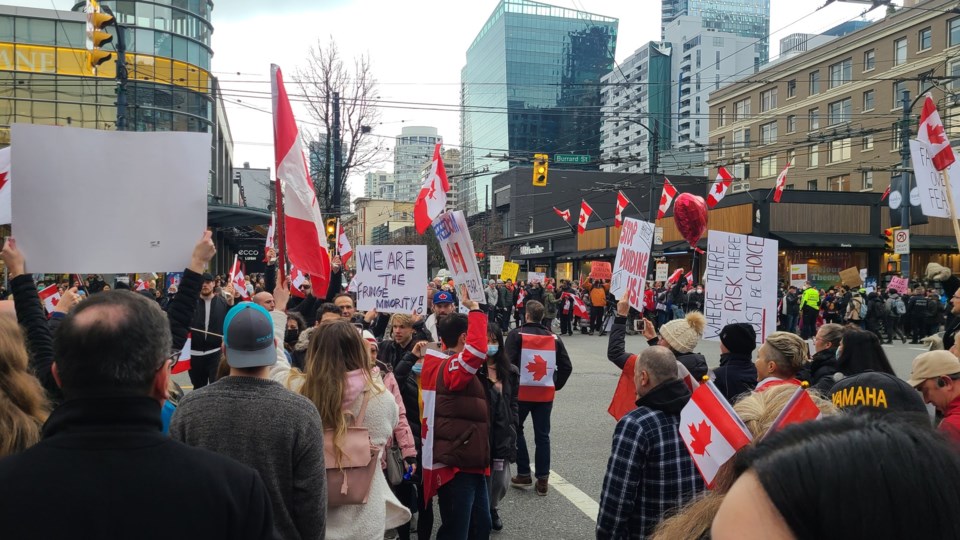The product of a highly polarized political atmosphere and the megaphone of social media, journalists – often women and people of colour – face abuse as they fall short of a false expectation.
Dr. Alfred Hermida, a professor at the School of Journalism at the University of British Columbia, said reporters facing public criticism is nothing new. However, the volume and virality of that criticism have only increased, sometimes manifesting as physical violence.
Earlier this month a video reporter in Edmonton was asked to remove CTV’s branding from a company vehicle in light of anti-vaccine mandate protesters targeting media.
While he believes the move a valid one, Hermida said the removal of a press vehicle’s decals is a far cry from a totally restricted press.
“I think given the level of harassment that we've seen in the past with journalists and what we've seen with the latest wave of protests it seems to be a sensible precaution,” Hermida said. "That's very different to somebody going in to talk to protesters and not saying they're a journalist.”
CBC to use unbranded vehicles
V.I.A. reached out to major players in Vancouver’s broadcast media scene to see if similar approaches to CTV Edmonton would be taken.
“CBC takes the responsibility of ensuring safety in the field for our employees very seriously. A recent and troubling reality has been the rising levels of harassment and abuse of our journalists while they report on stories,” a spokesperson for CBC Vancouver wrote. “Accordingly, we are taking the appropriate action of deploying unbranded vehicles to certain news events. This will help to ensure they can do the important work of bringing the day’s news to Canadians free from threats and harassment.”
Just as CTV Vancouver was targeted by anti-media protesters earlier this month, protest organizers had set their sights on Global BC newsroom in Burnaby for a Feb. 19 convoy. Those plans have since been cancelled in favour of protesting at the Pacific Highway border crossing in Surrey.
“The safety of our employees is of paramount concern,” a spokesperson for Global wrote of the protest as originally planned. “We are monitoring the situation closely but have no further comment to make at this time.”
V.I.A. also reached out to CityNews Vancouver and CTV Vancouver but did not receive a response.
How did we get here?
Pulling back, Hermida said it is important to understand how protesters arrive at blaming the media for perceived biases and lies. Restrictions under the COVID-19 pandemic have had severe impacts on mental health and on people's livelihoods, generally creating massive social change.
In a 2021 interview with V.I.A., Edwin Hodge, a sociologist at the University of Victoria, explained this environment makes the perfect incubator for conspiracy theories.
"In those times people's anxieties spike, people's fear spikes, Hodge said. “They get scared because the normal is gone and so they turn to anything that makes them feel like they have some sense of order or control."
It is at this point where Hermida believes people can start to have inconsistent beliefs.
"If what they read in the media doesn't align with their beliefs, often the people will respond to a thing called cognitive dissonance,” Hermida said. “'What you're telling me doesn't align with what I believe and what I believe to be true, I can't be wrong, you must be wrong.’ And therefore you sort of justify to yourself why the media is wrong."
False expectations of the media
Hermida explained that if someone is feeling this way a van branded with the decal of a national news organization could be seen as an easy target to let out that anger, even if journalists have no control over health restrictions.
“At the same time, journalists have a role in terms of how they frame these discussions,” Hermida said. “So [the media is] blamed for not representing and speaking for them."
This is especially challenging when common facts can no longer be agreed on.
“If you believe that COVID-19 is caused by 5G, then we can't have a reasonable discussion on the validity of health mandates," Hermida said. "If you don't believe that a journalist is approaching this story in good faith, trying to gather the evidence and report it as fairly and accurately as possible, then you can't have those discussions."
Generally, Hermida points to the polarized political system and social media for the amplification of these views and ideas.
"In some ways, I think journalists are doing the same thing with these protests, the more you cover the fact that 1,000 people are in Ottawa making a racket, the more it gives the impression this is a massive protest,” he said, offering that a qualifier acknowledging vaccination rates could help contextualize the story.
"Unfortunately, then you'd be accused by the protesters of not presenting their points of view," Hermida added.




